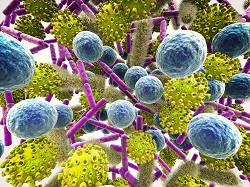Innovation and exploration through cutting-edge Microbiome research
Our own human microbiome is made up of communities of symbiotic, commensal and pathogenic bacteria as well as fungi and viruses. Our own body microbiome accounts for 100 times more genes, and over 1000 species live in our gut only. Human-hosted microbiome communities are found everywhere in our body - from our eyes, mouths and lungs to our skin, genitals and intestines.
Contributing to health and wellbeing
Some of these microorganisms have no effect on their hosts, while others like symbiotic bacteria offer a mutually beneficial relationship such as by breaking down food. Pathogens in the form of disease-causing opportunistic microorganism are also found but in smaller numbers. Currently there is a lack of understanding about the importance of the human gut microbiome, although it is known to affect the body’s ability to extract energy from food and influence brain function. Greater insights into the gut microbiome would therefore contribute to the development of dietary interventions and other new ways to treat both chronic and acute illnesses. But the microbiome is not just a feature of the human body, it is also found within livestock, plants, soil and the oceans. All of these interact in complex ways, which science has only just begun to comprehend. Hence, the microbiome represents a vast new area of research that offers the potential for nothing less than a food and nutrition revolution.
Highlighting groundbreaking EU research
Through the FP7 and Horizon 2020 framework programmes the EU has seized upon this unique opportunity to support ambitious cutting-edge research projects, allowing it to become a truly global leader in the study of microbiomes. This CORDIS Results Pack focuses on 13 EU-funded projects that are spearheading microbiome research. Initiatives such as FIBEBIOTICS examined how dietary fibre enhances our body’s immune defence against pathogens. In addition, SYSBIOFUN studied the body’s antifungal immune response, whilst FUNMETA investigated host-fungus interactions by focusing on metabolic pathways. State-of-the-art technologies were used by NUTRITECH to determine the role of phenotypic flexibility biomarkers in measuring health in humans. By identifying feed efficiency biomarkers in growing in cattle MARKEFFICIENCY was able to increase production in animals fed with high forage diets. Meanwhile, projects MUTFLYGUTBACT and AMIABLE employed insect and mammalian models in the form of fruit flies, ants and mice. The former identified a bacterial strain for use in probiotics. The later increased the scientific knowledge of the interactions between the host and symbiont bacteria for use in environmentally friendly pest control. Finally, the oceans represent the largest cohesive eco-system on earth. Hence the MACUMBA project isolated and cultivated marine microbial organisms to understand their role in the ocean biome. Furthermore, PHARMASEA investigated microbial genomes from extreme environments within the ocean depths, seeking bioactive compounds for treating infection and disease.



